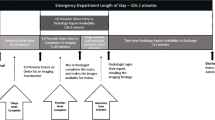Abstract
Actionable incidental findings (AIFs) are common imaging findings unrelated to the clinical indication for the imaging test for which follow-up is recommended. Increasing utilization of imaging in the emergency department (ED) in recent years has resulted in more patients with AIFs. When these findings are not properly communicated and followed up upon, there is harm to the patient’s health outcome as well as possible increased financial costs for the patient, the health system, and potential litigation. Tracking these findings can be difficult, especially so in a large health system. In this report, we detail our experience implementing a closed-loop AIF program within the ED of 11 satellite hospitals of a large academic health system. Our new workflow streamlined radiologist reporting of AIFs through system macros and by using a standardized form integrated into the dictation software. Upon completion of the form, an automatic email is sent to a dedicated nurse navigator who documented the findings and closed the loop by coordinating follow-up imaging or clinic visits with patients, primary care providers, and specialists. Through the new workflow, a total of 1207 incidental finding reports have been submitted from July 2021 to May 2022. The vast majority of AIFs were identified on CT, and the most common categories included lung nodules, pancreas lesions, liver lesions, and other potentially cancerous lesions. At least 10 new cancers have been detected. We hope this report can help guide other health systems in the design of a closed-loop incidental findings program.




Similar content being viewed by others
Explore related subjects
Discover the latest articles, news and stories from top researchers in related subjects.References
Kadom N, Venkatesh AK, Shugarman SA, Burleson JH, Moore CL, Seidenwurm D. Novel quality measure set: closing the completion loop on radiology follow-up recommendations for noncritical actionable incidental findings [published online ahead of print, 2022 May 20]. J Am Coll Radiol. 2022;S1546–1440(22)00282–4. https://doi.org/10.1016/j.jacr.2022.03.017
Moore CL, Kadom N, Seidenwurm D, et al. Incidental findings: a survey of radiologists and emergency physicians. J Am Coll Radiol. 2021;18(6):853-856. https://doi.org/10.1016/j.jacr.2020.12.027
Levine DM, Linder JA, Landon BE. Characteristics of Americans with primary care and changes over time, 2002-2015. JAMA Intern Med. 2020;180(3):463–466. https://doi.org/10.1001/jamainternmed.2019.6282
Hanna TN, Shekhani H, Zygmont ME, Kerchberger JM, Johnson JO. Incidental findings in emergency imaging: frequency, recommendations, and compliance with consensus guidelines. Emerg Radiol. 2016;23(2):169-174. https://doi.org/10.1007/s10140-016-1378-1
Crable EL, Feeney T, Harvey J, et al. Management strategies to promote follow-up care for incidental findings: a scoping review. J Am Coll Radiol. 2021;18(4):566-579. https://doi.org/10.1016/j.jacr.2020.11.006
Schwartz FR, Roth CJ, Boardwine B, et al. Electronic health record closed-loop communication program for unexpected nonemergent findings. Radiology. 2021;301(1):123-130. https://doi.org/10.1148/radiol.2021210057
Reeves K. Tracking actionable incidental findings. American College of Radiology. https://www.acr.org/Practice-Management-Quality-Informatics/Imaging-3/Case-Studies/Quality-and-Safety/Tracking-Actionable-Incidental-Findings?utm_source=sb&utm_medium=text&utm_campaign=imag_0520_imaging3_tracking_actionable_incidental_findings. Published May 2022. Accessed May 22, 2022
MacMahon H, Naidich DP, Goo JM, et al. Guidelines for management of incidental pulmonary nodules detected on CT images: from the Fleischner Society 2017. Radiology. 2017;284(1):228-243. https://doi.org/10.1148/radiol.2017161659
Incidental Findings. American College of Radiology. (n.d.). Retrieved July 1, 2022, from https://www.acr.org/Clinical-Resources/Incidental-Findings
Selvarajan SK, Levin DC, Parker L. The increasing use of emergency department imaging in the United States: is it appropriate?. AJR Am J Roentgenol. 2019;213(4):W180-W184. https://doi.org/10.2214/AJR.19.21386
Treskes K, Bos SA, Beenen LFM, et al. High rates of clinically relevant incidental findings by total-body CT scanning in trauma patients; results of the REACT-2 trial [published correction appears in Eur Radiol. 2017 Jun;27(6):2463]. Eur Radiol. 2017;27(6):2451–2462. https://doi.org/10.1007/s00330-016-4598-6
Lumbreras B, Donat L, Hernández-Aguado I. Incidental findings in imaging diagnostic tests: a systematic review. Br J Radiol. 2010;83(988):276-289. https://doi.org/10.1259/bjr/98067945
Munk MD, Peitzman AB, Hostler DP, Wolfson AB. Frequency and follow-up of incidental findings on trauma computed tomography scans: experience at a level one trauma center. J Emerg Med. 2010;38(3):346-350. https://doi.org/10.1016/j.jemermed.2008.01.021
Paluska TR, Sise MJ, Sack DI, Sise CB, Egan MC, Biondi M. Incidental CT findings in trauma patients: incidence and implications for care of the injured. J Trauma. 2007;62(1):157-161. https://doi.org/10.1097/01.ta.0000249129.63550.cc
Prabhakar AM, Le TQ, Abujudeh HH, Raja AS. Incidental findings and recommendations are common on ED CT angiography to evaluate for aortic dissection. Am J Emerg Med. 2015;33(11):1639–1641. https://doi.org/10.1016/j.ajem.2015.07.078
Hansra SS, Loehfelm TW, Wilson M, Corwin MT. Factors affecting adherence to recommendations for additional imaging of incidental findings in radiology reports. J Am Coll Radiol. 2021;18(2):233-239. https://doi.org/10.1016/j.jacr.2020.02.021
Thompson RJ, Wojcik SM, Grant WD, Ko PY. Incidental findings on CT scans in the emergency department. Emerg Med Int. 2011;2011:624847. https://doi.org/10.1155/2011/624847
Author information
Authors and Affiliations
Contributions
All authors contributed to the conception, design, and implementation of the workflow. Material preparation, data collection, and analysis were performed by Tianyuan Fu, Sheila Berlin, and Jennifer Sommer. The first draft of the manuscript was written by Tianyuan Fu and all authors commented on previous versions of the manuscript. All authors read and approved the final manuscript.
Corresponding author
Ethics declarations
Ethics Approval
The Institutional Review Board has confirmed that no ethical approval is required.
Consent to Participate
The requirement for informed consent was waived by the institutional review board.
Consent for Publication
Not applicable.
Conflict of Interest
The authors declare no competing interests.
Additional information
Publisher's Note
Springer Nature remains neutral with regard to jurisdictional claims in published maps and institutional affiliations.
Rights and permissions
Springer Nature or its licensor (e.g. a society or other partner) holds exclusive rights to this article under a publishing agreement with the author(s) or other rightsholder(s); author self-archiving of the accepted manuscript version of this article is solely governed by the terms of such publishing agreement and applicable law.
About this article
Cite this article
Fu, T., Berlin, S., Gupta, A. et al. Implementing a Streamlined Radiology Workflow to Close the Loop on Incidental Imaging Findings in the Emergency Department. J Digit Imaging 36, 776–786 (2023). https://doi.org/10.1007/s10278-022-00773-x
Received:
Revised:
Accepted:
Published:
Issue Date:
DOI: https://doi.org/10.1007/s10278-022-00773-x





